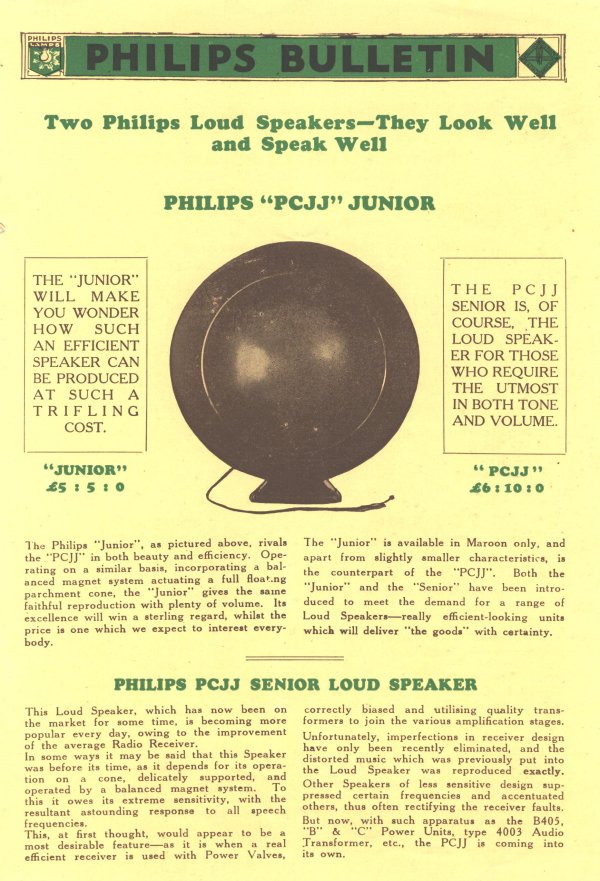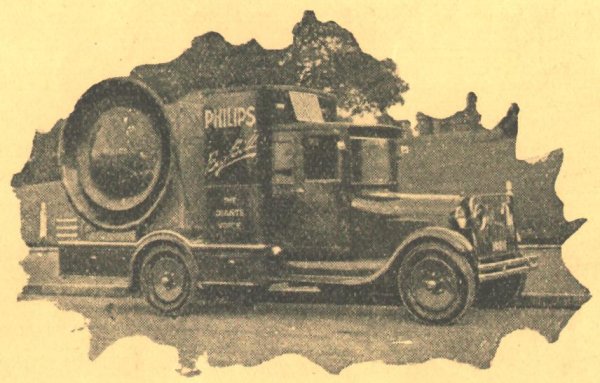
| VK2DYM'S MILITARY RADIO AND RADAR INFORMATION SITE. |
PHILIPS SPEAKERS - 1927-1932

INTRODUCTION
Although AWA (Amalgamated Wireless Australasia) is well known in Australian radio markets we should not forget that the Dutch company, Philips, was also very active in this country. These pages give an idea of that company's audio speaker products in the early years of domestic radio, in Australia.
Philips Lamps (A/sia) Pty. Ltd., with a head office in Clarence St., Sydney and branch offices in Melbourne, Brisbane and Adelaide, imported a range of speakers, power supplies, valves, components, record pick ups and later complete receivers, in addition to their lighting and X-ray products. In August 1927 they introduced the "PHILIPS BULLETIN", a bi-monthly 4 page A5 publication with information and prices for their dealers. Then in December 1929 it became "THE PHILIPS SPEAKER" a quarterly 4 page broadsheet paper. Much of the information here is taken from those bulletins and will give collectors an idea of the products and the date of introduction. The cover featured above is from a binder for the early bulletins.
Here is the front page of Series 1, Issue 1 which explains the rationale for publishing the Bulletin.

The "PCJJ" speaker was introduced in Europe in 1926 and was on the Australian market in early 1927. It was named after the Dutch overseas broadcast station, call sign PCJ. The price was £6/10/- and it was available in brown, red with brass fleck and buff colours and in plain or mottled tones. As well as the name, Philips allocated type numbers to their products and the "PCJJ" was Type No. (ah, I dunno).
In early 1928 Philips introduced a smaller version, the "PCJJ" Junior. It was of identical design, just smaller and only available in maroon colour. It sold for £5/5/-. The Type No. was 2007 ? To give some perspective, the average weekly wage at this time was around £6/-/-.

The larger model became the "PCJJ Senior", although the word "Senior" was not always noted in the advertising. Both speakers were moulded from bakelite plastic, with parchment cones driven by a speaker mechanism known as a 4 pole balanced armature and claimed to have been developed by Philips. The way this works is outlined below.
|
|
|
A horse shoe type permanent magnet A is fitted with additional alternating pole pieces so that it has North poles at N1 and N2 and South poles at Z1 and Z2. An armature and coil will be located in the axis G--H |
 |
|
Here the soft steel armature and coil S are in place. When an electric current is passed through the coil S, it induces magnetic polarity in the armature so that it will move towards the right or left, depending on the polarity of the current. |
 |
This shows the mechanical components in a simplified form. Flat springs V1 and V2 are attached to non-magnetic brackets P and Q. The armature K and coil S are attached to the flat springs on the axis G--H. When electric current is applied to the coil, it and the armature move back and forth on the axis a--b. |
 |
|
This diagram shows the horseshoe magnet at M, with a non-magnetic bracket attached by 2 screws and the added pole pieces at the open end, top and bottom, attached with nuts and threaded studs. One flat spring is visible at V1. The coil can be seen in the centre of the magnet. The armature consists of 2 rods, L1 and L2 attached to the flat springs plus a yoke consisting of the bracket and rod B. The end of B is directly attached to the centre of the speaker cone. When an alternating (audio) current is applied to the coil via the leads shown, rod B will move back and forth (left/right according to the diagram on the page) and hence move the speaker cone, creating sound waves. |
The Philips speakers could also be mounted on walls, ceilings, or fitted with a bracket etc, as shown in this advert.

Of course Philips was not the only supplier of speakers and it is interesting to see how similar the Amplion range was in March 1928.
 |
 |
| AMPLION AC1 cone speaker with metal bracket. | Larger AC3 version on a moulded stand. |
 |
 |
| Another model of Amplion Cone Speaker, the AC2. | The Amplion AC2H ceiling mount version. |
In October 1928 Philips extended the speaker range with the "Baby Grand" speaker. This was a low price model, £3/15/-, with no protective front cover over the speaker cone. The Type No. for the "Baby Grand" was 2020.

The "Baby Grand" was available with a mottled bakelite surround and matching cone or with a plainer surround and a plain cone, as shown below.

The range of speakers was therefore as illustrated below, where the pictures give an idea of the relative size of each product.

In June 1929 Philips announced two additions to their speaker range, the "Permagnetic" and the "Peter Pan". The "Permagnetic" introduced rudimentary baffling of the speaker by enclosing it in an open backed cabinet. There were 4 versions available:
Type 2009 - Table
Model with short legs.
Type 2010 - Table
Model with a Type 2750 audio amplifier included.
Type 2011 - Floor
Model with long legs.
Type 2012 - Floor
Model with the addition of the Type 2750 amplifier.
Details of the 2750 amplifier are given in a later section.
 |
 |
| A thing of beauty !! The cabinet was a substantial piece of woodwork and had a handle on each side to allow it to be manhandled around the room. It looks almost like a piano stool onto which a speaker box has been grafted. | The audio transformer had a low impedance input tap and a high impedance tap for direct connection to a penthode (correct spelling at that time) output valve. The Type 2750 audio amplifier, if supplied, could be fitted inside the cabinet. |
The "Permagnetic" used a moving coil and a large permanent magnet and sold for £19/10/- for both table or floor versions and the considerable sum of £37/-/- with the audio amplifier included.
The "Peter Pan", released at the same time, was a larger version of the "PCJJ" and sold for £7/10/- compared to the "PCJJ" at £6/10/-. It featured a 3 position rotary switch in the connecting lead that altered the impedance and hence the tone.

Only a few months later, in August 1929, another speaker was introduced, this time the "Concert Grand", Type No. xx, costing £8/10/- and incorporating the 3 position tone switch that had been introduced with the "Peter Pan". The "Concert Grand" was similar to the "Baby Grand", using the same mechanism, but housed in an enclosed cabinet to get a baffled effect. I have not seen a "Concert Grand" so can only speculate that it was moulded in bakelite but as it was offered in silver or gold it would have been painted.

Note the tone switch in the connecting lead. The features of the "Concert Grand" were extolled in the following release:

At around the same time, in late 1929, options for the "Baby Grand" were introduced as per the following release:

When the advertising gurus referred to the buff coloured version being "quiet" they meant the colour was muted compared to the original. Interestingly the buff colour was more expensive than the original model.
As if this choice was not enough, in September 1929 Philips introduced the "Sevenette" (Type No. 2019) which was a bakelite cabinet version of the "Concert Grand" with a metal protective grill over the front.

Towards the end of 1929 Philips reduced the prices of their speaker range. The original "PCJJ" was now called the "PCJJ Senior". The "PCJJ Junior" and newly introduced "Sevenette" do not appear because their prices were unchanged.

I am unaware of the model listed above as the "Moving Coil Unit ...." It may be the speaker unit out of the "Permagnetic".
Around this time, late 1929, Philips (Sydney) introduced the ultimate speaker for the connoisseur, affectionately known as "Big Bill".

It was actually a 500 watt PA system mounted on an A model Ford truck and styled to look like the PCJJ/Peter Pan speakers. Philips rented it out for sporting functions etc.
It was also around the end of 1929 that Philips suggested means of reducing the unfavourable sound wave interaction from an unbaffled speaker, with a short article on how to add a baffle to a speaker unit. The example used was the "Baby Grand" and the solution was simply to add a large timber or plasterboard surround to the speaker. The theory was that the sound had further to travel round to the back of the speaker to cause interference and deterioration in audio quality. It appears the speaker has been mounted on a wooden lamp base.

The "Permagnetic" speaker is illustrated as an example of a baffled speaker unit.
During 1930 the buying public's aesthetic appreciation had changed and the PCJJ and Sevenette style became unfashionable and were gradually phased out. In their place, Philips introduced timber cabinet speakers which followed the trend for "cathedral" style wireless sets.

Philips called these the "Campanilla" range. At top is the table model, £10/15/-, and below is the floor model selling for £9/15/-. They were constructed from timber and timber veneers and used moving coil speakers but I have no further information on them.
THE PHILIPS 2750 AUDIO AMPLIFIER.
In June 1929 Philips introduced two audio amplifiers to the Australian market. The Type 2781 was for phonograph amplification whilst the other, as the Type 2750 for moving coil speakers, or the Type 2754 for cone speakers, was intended as a speaker amplifier. Both used Philips components that had been available to kit builders prior to Philips marketing these complete units. The 2750 was supplied as an option with the Permagnetic speaker detailed above.
 |
| Philips Type 2750/2754 audio amplifier for speaker amplification. It was housed in a grey/blue "crystallined" (wrinkle) finish metal case similar to those used for the Philips power supplies. The front cover hinged down for access. The price of the 2750/2754 amplifier was £17/10/- including valves. |
 |
| The 2750/2754 10 watt amplifier used a
Philips 505 half wave rectifier valve (although the caption above
indicates a 506 full wave rectifier valve) and an E443 penthode amplifier
valve. The only difference between the 2750 (moving coil speaker) and 2754
(cone speaker) was in the output transformer. The amplifier included an
inbuilt power supply using the Philips Type 3003 and Type 4009 filament
transformer. HT was 400 v DC. As a safety measure, a contact piece on the
hinged cover operated a switch to disconnect power when the cover was
opened. Two neon lamps, visible through holes in the cover, indicated
overload on the output tube if the input volume was too high. A form of
volume control was achieved by taps on the secondary of the input
transformer. The Philips 505 valve cost 22/6, the 506 was 25/- and the E443 was 45/-. |
Please note, this article is copyrighted.